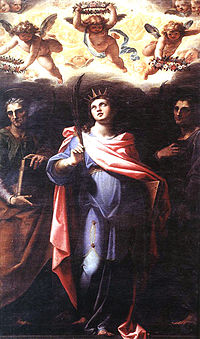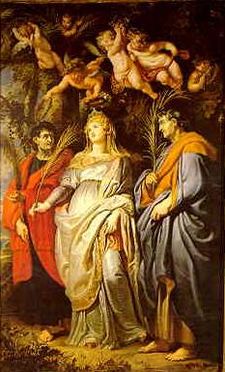- Nereus, Achilleus, Domitilla, and Pancras
-
Saints Nereus and Achilleus, Domitilla, and Saint Pancras 
Domitilla, with Saints Nereus and Achilleus, by Nicclò CircignaniHonored in Roman Catholic Church Major shrine Santi Nereo e Achilleo Feast 12 May Nereus, Achilleus, Domitilla, and Pancras are martyrs of the Roman Catholic Church.
In the General Roman Calendar of 1962, they have a third-class feast on 12 May.
In the Roman Catholic calendar of saints, there are distinct celebrations of Nereus and Achilleus (together) and of Pancras of Rome. Both are optional memorials on 12 May. Before 1595, the calendar did not celebrate Domitilla, judging that the liturgical honours once paid her "have no basis in tradition".[1]
Contents
Nereus and Achilleus
The old Roman lists of the 5th century, which passed over into the Martyrologium Hieronymianum, contain the names of the two martyrs Nereus and Achilleus, whose grave was in the Catacomb of Domitilla on the Via Ardeatina. The notice in the more- complete version given by the Berne Codex (ed. de Rossi-Duchesne, Acta SS., Nov., II, [59]), reads: IIII id. Maii, Romae in coemeterio Praetextati natale Nerei et Achillei fratrum (On 12 May at Rome in the cemetery of Praetextatus [an evident error for Domitilla?] the natal day of the brothers Nereus and Achilleus").
In the invocation of the Mass for 12 May in the "Sacramentarium Gelasianum", the names of Nereus and Achilleus alone are mentioned. In the fourth and following centuries a special votive Mass was celebrated on 12 May at the grave of Saints Nereus and Achilleus on the Via Ardeatina. The Itineraries of the graves of the Roman martyrs, written in the 7th century, are unanimous in their indication of the resting-place of these saints (Giovanni Battista de Rossi, "Roma sotterranea", I, 180-83).
The church built over the grave of Sts. Nereus and Achilleus in the Via Ardeatina, is of the latter part of the 4th century; it is a three-naved basilica, and was discovered by de Rossi in the Catacomb of Domitilla. Amongst the numerous objects found in the ruins were two pillars which had supported the ciborium ornamented with sculptures representing the death of the two saints by decapitation; one of these pillars is perfectly preserved, and the name of Achilleus is carved on it. There was also found a large fragment of a marble slab, with an inscription composed by Pope Damasus, the text of which is well-known from an ancient copy. This oldest historical mention of the two saints (Weyman, "Vier Epigramme des h. Papstes Damasus", Munich, 1905; de Rossi, "Inscriptiones christianae", II, 31; Ihm, "Damasi epigrammata", Leipzig, 1895, 12, no. 8) tells how Nereus and Achilleus as soldiers were obedient to the tyrant, but suddenly being converted to Christianity, joyfully resigned their commission and did the martyr's death; as to the date of their glorious confession we can make no inference. The acts of these martyrs, legendary even to a romantic degree, have no historical value for their life and death; they bring no fewer than thirteen different Roman martyrs into relation, amongst them even Simon Magus, according to the apocryphal Petrine Acts, and place their death in the end of the first and beginning of the 2nd centuries. These Acts were written in Greek and Latin; according to Achelis (see below) the Greek was the original text, and written in Latin in the 6th century; Schaefer (see below) on the other hand holds the Latin to have been the older version, and seeks to prove that it emanated from the first half of the 5th century; so remote a date is improbable, and the 6th century is to be preferred as the source of the Acts.
Legend
According to these legends, Nereus and Achilleus were eunuchs and Chamberlains of Flavia Domitilla, a niece of the Emperor Domitian; with the Christian virgin, they had been banished to the island of Ponza (Pontia), and later on beheaded in Terracina. The graves of these two martyrs were on an estate of the Lady Domitilla near the Via Ardeatina, close to that of Saint Petronilla.
The author of this legend places the two saints quite differently from the poem of Pope Damasus: as Nereus and Achilleus were buried in a very ancient part of the catacomb of Domitilla, built as far back as the beginning of the 2nd century, we may conclude that they are among the most ancient martyrs of the Roman Church, and stand in very near relation to the Flavian family, of which Domitilla, the foundress of the catacomb, was a member. In the Epistle to the Romans, St. Paul mentions a Nereus with his sister, to whom he sends greetings (Romans 16:15); perhaps even the martyr was a descendant of this disciple of the Apostle of the Gentiles. Owing to the purely legendary character of these Acts, we cannot use them as an argument to aid in the controversy whether there were two Christians of the name of Domitilla in the family of the Christian Flavian, or only one: the wife of the Consul Titus Flavius Clemens. As to other martyrs of the name Nereus, who are especially noted in the old martyrologies as martyrs of the faith in Africa, or as being natives of that country (e.g., in the Martyrologium Hieronymianum, 11 May, 15 or 16 October, 16 November) though there is one of the name in the present Roman Martyrology under date of 16 October, nothing more is known.
The relics of Domitilla, Nereus and Achilleus are housed under the high altar of the church of Santi Nereo e Achilleo.
See also
References
- ^ Calendarium Romanum (Libreria Editrice Vaticana), p. 123
 This article incorporates text from a publication now in the public domain: Herbermann, Charles, ed (1913). "Sts. Nereus and Achilleus, Domitilla and Pancratius". Catholic Encyclopedia. Robert Appleton Company.Categories:
This article incorporates text from a publication now in the public domain: Herbermann, Charles, ed (1913). "Sts. Nereus and Achilleus, Domitilla and Pancratius". Catholic Encyclopedia. Robert Appleton Company.Categories:- Christian martyrs of the Roman era
- Articles about multiple people
- 1st-century Christian martyr saints
Wikimedia Foundation. 2010.

